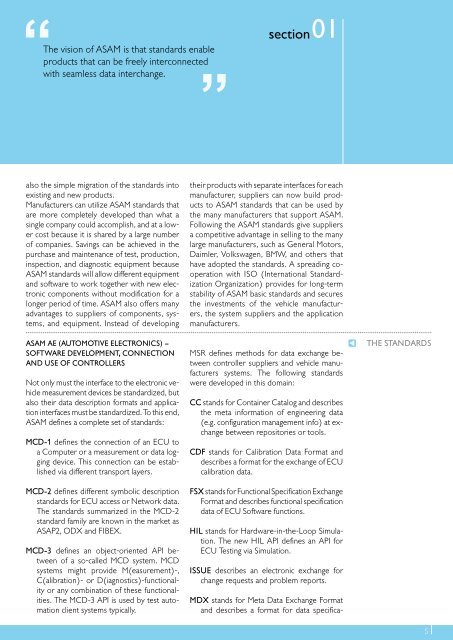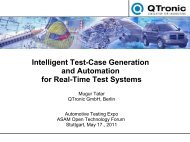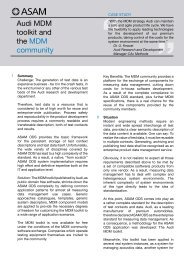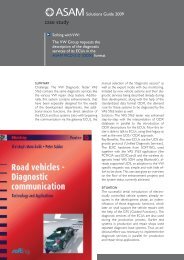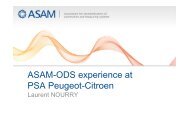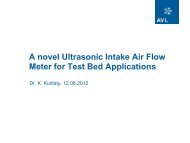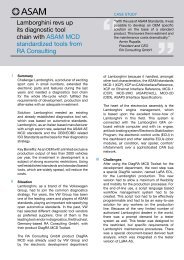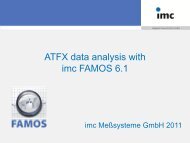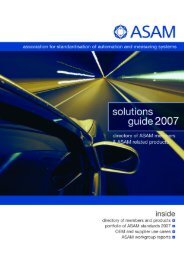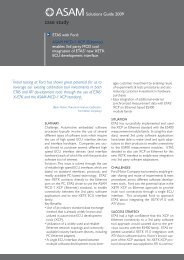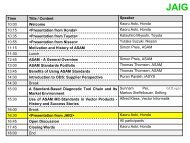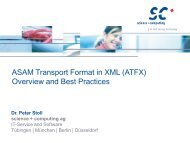Download now - ASAM
Download now - ASAM
Download now - ASAM
- TAGS
- download
- asam
- www.asam.net
You also want an ePaper? Increase the reach of your titles
YUMPU automatically turns print PDFs into web optimized ePapers that Google loves.
The vision of <strong>ASAM</strong> is that standards enable<br />
products that can be freely interconnected<br />
with seamless data interchange<br />
also the simple migration of the standards into<br />
existing and new products<br />
Manufacturers can utilize <strong>ASAM</strong> standards that<br />
are more completely developed than what a<br />
single company could accomplish, and at a lower<br />
cost because it is shared by a large number<br />
of companies Savings can be achieved in the<br />
purchase and maintenance of test, production,<br />
inspection, and diagnostic equipment because<br />
<strong>ASAM</strong> standards will allow different equipment<br />
and software to work together with new electronic<br />
components without modification for a<br />
longer period of time <strong>ASAM</strong> also offers many<br />
advantages to suppliers of components, systems,<br />
and equipment Instead of developing<br />
<strong>ASAM</strong> AE (AuTOMOTIvE ELECTROnICS) –<br />
SOfTWARE DEvELOPMEnT, COnnECTIOn<br />
AnD uSE Of COnTROLLERS<br />
Not only must the interface to the electronic vehicle<br />
measurement devices be standardized, but<br />
also their data description formats and application<br />
interfaces must be standardized To this end,<br />
<strong>ASAM</strong> defines a complete set of standards:<br />
MCD-1 defines the connection of an ECU to<br />
a Computer or a measurement or data logging<br />
device This connection can be established<br />
via different transport layers<br />
MCD-2 defines different symbolic description<br />
standards for ECU access or Network data<br />
The standards summarized in the MCD-2<br />
standard family are k<strong>now</strong>n in the market as<br />
ASAP2, ODX and FIBEX<br />
MCD-3 defines an object-oriented API between<br />
of a so-called MCD system MCD<br />
systems might provide M(easurement)-,<br />
C(alibration)- or D(iagnostics)-functionality<br />
or any combination of these functionalities<br />
The MCD-3 API is used by test automation<br />
client systems typically<br />
01 section<br />
their products with separate interfaces for each<br />
manufacturer, suppliers can <strong>now</strong> build products<br />
to <strong>ASAM</strong> standards that can be used by<br />
the many manufacturers that support <strong>ASAM</strong><br />
Following the <strong>ASAM</strong> standards give suppliers<br />
a competitive advantage in selling to the many<br />
large manufacturers, such as General Motors,<br />
Daimler, Volkswagen, BMW, and others that<br />
have adopted the standards A spreading cooperation<br />
with ISO (International Standardization<br />
Organization) provides for long-term<br />
stability of <strong>ASAM</strong> basic standards and secures<br />
the investments of the vehicle manufacturers,<br />
the system suppliers and the application<br />
manufacturers<br />
MSR defines methods for data exchange between<br />
controller suppliers and vehicle manufacturers<br />
systems The following standards<br />
were developed in this domain:<br />
CC stands for Container Catalog and describes<br />
the meta information of engineering data<br />
(e g configuration management info) at exchange<br />
between repositories or tools<br />
CDf stands for Calibration Data Format and<br />
describes a format for the exchange of ECU<br />
calibration data<br />
fSX stands for Functional Specification Exchange<br />
Format and describes functional specification<br />
data of ECU Software functions<br />
hIL stands for Hardware-in-the-Loop Simulation<br />
The new HIL API defines an API for<br />
ECU Testing via Simulation<br />
ISSuE describes an electronic exchange for<br />
change requests and problem reports<br />
MDX stands for Meta Data Exchange Format<br />
and describes a format for data specifica-<br />
ThE STAnDARDS<br />
5


